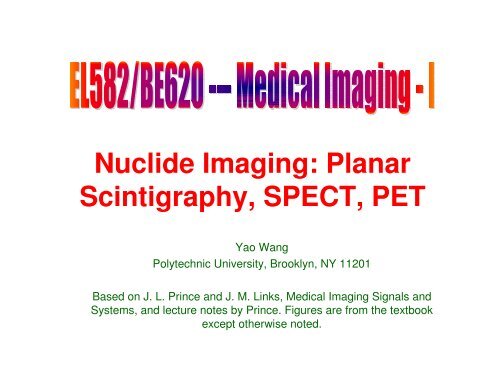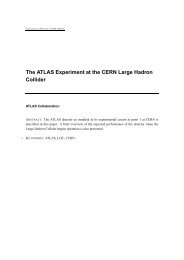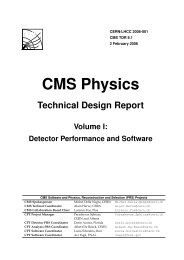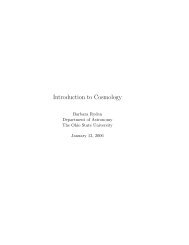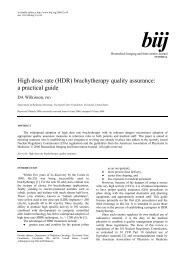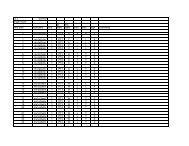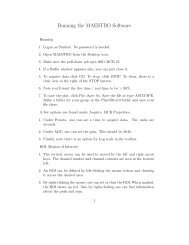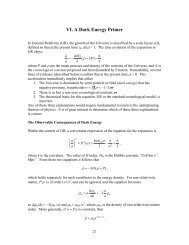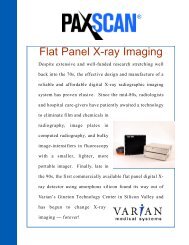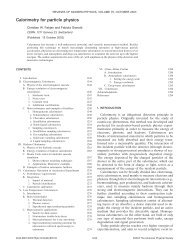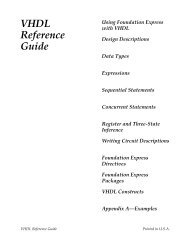Nuclide Imaging: Planar Scintigraphy, SPECT, PET - Polytechnic ...
Nuclide Imaging: Planar Scintigraphy, SPECT, PET - Polytechnic ...
Nuclide Imaging: Planar Scintigraphy, SPECT, PET - Polytechnic ...
Create successful ePaper yourself
Turn your PDF publications into a flip-book with our unique Google optimized e-Paper software.
<strong>Nuclide</strong> <strong>Imaging</strong>: <strong>Planar</strong><strong>Scintigraphy</strong>, <strong>SPECT</strong>, <strong>PET</strong>Yao Wang<strong>Polytechnic</strong> University, Brooklyn, NY 11201Based on J. L. Prince and J. M. Links, Medical <strong>Imaging</strong> Signals andSystems, and lecture notes by Prince. Figures are from the textbookexcept otherwise noted.
• <strong>Nuclide</strong> <strong>Imaging</strong> OverviewLecture Outline• Review of Radioactive Decay• <strong>Planar</strong> <strong>Scintigraphy</strong>– Scintillation camera– <strong>Imaging</strong> equation• Single Photon Emission Computed Tomography(<strong>SPECT</strong>)• Positron Emission Tomography (<strong>PET</strong>)• Image Quality consideration– Resolution, noise, SNR, blurringEL5823 Nuclear <strong>Imaging</strong> Yao Wang, <strong>Polytechnic</strong> U., Brooklyn 2
What is Nuclear Medicine• Also known as nuclide imaging• Introduce radioactive substance intobody• Allow for distribution anduptake/metabolism of compound⇒ Functional <strong>Imaging</strong>!• Detect regional variations ofradioactivity as indication ofpresence or absence of specificphysiologic function• Detection by “gamma camera” ordetector array• (Image reconstruction)From H. Graber, Lecture Note for BMI1, F05EL5823 Nuclear <strong>Imaging</strong> Yao Wang, <strong>Polytechnic</strong> U., Brooklyn 3
Examples: <strong>PET</strong> vs. CT• X-ray projection andtomography:– X-ray transmitted through abody from a outside source toa detector (transmissionimaging)– Measuring anatomic structure• Nuclear medicine:– Gamma rays emitted fromwithin a body (emissionimaging)– <strong>Imaging</strong> of functional ormetabolic contrasts (notanatomic)• Brain perfusion, function• Myocardial perfusion• Tumor detection(metastases)From H. Graber, Lecture Note, F05EL5823 Nuclear <strong>Imaging</strong> Yao Wang, <strong>Polytechnic</strong> U., Brooklyn 4
What is Radioactivity?EL5823 Nuclear <strong>Imaging</strong> Yao Wang, <strong>Polytechnic</strong> U., Brooklyn 5
Positron Decay and Electron Capture• Also known as Beta Plus decay– A proton changes to a neutron, a positron (positive electron), and aneutrino– Mass number A does not change, proton number Z reduces• The positron may later annihilate a free electron, generate twogamma photons in opposite directions– These gamma rays are used for medical imaging (Positron EmissionTomography)From: http://www.lbl.gov/abc/wallchart/chapters/03/2.htmlEL5823 Nuclear <strong>Imaging</strong> Yao Wang, <strong>Polytechnic</strong> U., Brooklyn 6
Gamma Decay (Isometric Transition)• A nucleus (which is unstable) changes from a higher energy state toa lower energy state through the emission of electromagneticradiation (photons) (called gamma rays). The daughter and parentatoms are isomers.– The gamma photon is used in Single photon emission computedtomography (<strong>SPECT</strong>)• Gamma rays have the same property as X-rays, but are generateddifferent:– X-ray through energetic electron interactions– Gamma-ray through isometric transition in nucleusFrom: http://www.lbl.gov/abc/wallchart/chapters/03/3.htmlEL5823 Nuclear <strong>Imaging</strong> Yao Wang, <strong>Polytechnic</strong> U., Brooklyn 7
Measurement of Radioactivity(orig.: activity of 1 g of 226Ra)Bq=BequerelCi=Curie:Naturally occurring radioisotopes discovered 1896 by BecquerelFirst artificial radioisotopes produced by the Curies 1934 (32P)The intensity of radiation incident on a detector at range r from a radioactivesource isIAE=4πrA: radioactivity of the material; E: energy of each photon2EL5823 Nuclear <strong>Imaging</strong> Yao Wang, <strong>Polytechnic</strong> U., Brooklyn 8
Radioactive Decay Law• N(t): the number of radioactive atoms at a given time• A(t): is proportional to N(t)• From above, we can derive• The number of photons generated (=number of disintegrations)during time T is•∆N=T∫0A(t)dt=dNA = − = λNdtλ :decay constantT∫0N(t)=A(t)=λN0eNA e0−λt0edt−λt−λt== λNN00e−λt(1 −e−λT)EL5823 Nuclear <strong>Imaging</strong> Yao Wang, <strong>Polytechnic</strong> U., Brooklyn 9
Common RadiotracersThyroid functionKidney functionMost commonly usedOxygen metabolismEL5823 Nuclear <strong>Imaging</strong> Yao Wang, <strong>Polytechnic</strong> U., Brooklyn 10
Overview of <strong>Imaging</strong> Modalities• <strong>Planar</strong> <strong>Scintigraphy</strong>– Use radiotracers that generate gammay decay, which generates onephoton in random direction at a time– Capture photons in one direction only, similar to X-ray, but uses emittedgamma rays from patient– Use an Anger scintillation camera• <strong>SPECT</strong> (single photon emission computed tomography)– Use radiotracers that generate gammay decay– Capture photons in multiple directions, similar to X-ray CT– Uses a rotating Anger camera to obtain projection data from multipleangles• <strong>PET</strong> (Positron emission tomography)– Uses radiotracers that generate positron decay– Positron decay produces two photons in two opposite directions at atime– Use special coincidence detection circuitry to detect two photons inopposite directions simultaneously– Capture projections on multiple directionsEL5823 Nuclear <strong>Imaging</strong> Yao Wang, <strong>Polytechnic</strong> U., Brooklyn 11
<strong>Planar</strong> <strong>Scintigraphy</strong>• Capture the emitted gammaphotons (one at a time) in asingle direction• <strong>Imaging</strong> principle:– By capturing the emittedgamma photons in oneparticular direction, determinethe radioactivity distributionwithin the body– On the contrary, X-rayimaging tries to determine theattenuation coefficient to thex-rayEL5823 Nuclear <strong>Imaging</strong> Yao Wang, <strong>Polytechnic</strong> U., Brooklyn 12
Anger Scintillation CameraCompare the detected signal to a thresholdCompute the location with highest activityConvert light to electrical currentsConvert detected photons to lightsAbsorb scattered photonsEL5823 Nuclear <strong>Imaging</strong> Yao Wang, <strong>Polytechnic</strong> U., Brooklyn 13
CollimatorsEL5823 Nuclear <strong>Imaging</strong> Yao Wang, <strong>Polytechnic</strong> U., Brooklyn 14
• Scintillation crystal:Scintillation Detector– Emit light photons after deposition of energy in the crystal byionizing radiation– Commonly used crystals: NaI(Tl), BGO, CsF, BaF 2– Criteria: Stopping power, response time, efficiency, energyresolution• Detectors used for planar scintigraphyEL5823 Nuclear <strong>Imaging</strong> Yao Wang, <strong>Polytechnic</strong> U., Brooklyn 15
Photomultiplier Tubes• Each tube converts a light signal to an electrical signaland amplifies the signalEL5823 Nuclear <strong>Imaging</strong> Yao Wang, <strong>Polytechnic</strong> U., Brooklyn 16
Inside a Photomultiplier Tube10^6-10^8 electronsreach anode for eachelectron liberated fromthe cathodeIncreasing in voltage,Repeatedly generates moreelectrons, 10-14 stepsDynode: positivelychargedFor each electronreaching a dynode, 3-4electrons are releasedFor every 7-10photons incident uponthe photocathode, anelectron is releasedOutputs a current pulse each time a gamma photon hits the scintillation crystal.This current pulse is then converted to a voltage pulse through a preamplifier circuit.EL5823 Nuclear <strong>Imaging</strong> Yao Wang, <strong>Polytechnic</strong> U., Brooklyn 17
Positioning LogicEach incident photon causes responses at all PMTs, but the amplitude ofthe response is proportional to its distance to the location where the photonoriginates. Positioning logic is used to estimate this location.EL5823 Nuclear <strong>Imaging</strong> Yao Wang, <strong>Polytechnic</strong> U., Brooklyn 18
Pulse Height CalculationEL5823 Nuclear <strong>Imaging</strong> Yao Wang, <strong>Polytechnic</strong> U., Brooklyn 19
Pulse Height AnalysisEL5823 Nuclear <strong>Imaging</strong> Yao Wang, <strong>Polytechnic</strong> U., Brooklyn 20
Acquisition ModesEL5823 Nuclear <strong>Imaging</strong> Yao Wang, <strong>Polytechnic</strong> U., Brooklyn 21
List ModeEL5823 Nuclear <strong>Imaging</strong> Yao Wang, <strong>Polytechnic</strong> U., Brooklyn 22
Single Frame ModeThe value in each pixel indicates the number of events happened in that location over theentire scan timeEL5823 Nuclear <strong>Imaging</strong> Yao Wang, <strong>Polytechnic</strong> U., Brooklyn 23
Dynamic Frame ModeEL5823 Nuclear <strong>Imaging</strong> Yao Wang, <strong>Polytechnic</strong> U., Brooklyn 24
Multiple Gated AcquisitionEL5823 Nuclear <strong>Imaging</strong> Yao Wang, <strong>Polytechnic</strong> U., Brooklyn 25
<strong>Imaging</strong> Geometry and Assumptionz(x,y)EL5823 Nuclear <strong>Imaging</strong> Yao Wang, <strong>Polytechnic</strong> U., Brooklyn 26
<strong>Imaging</strong> EquationEL5823 Nuclear <strong>Imaging</strong> Yao Wang, <strong>Polytechnic</strong> U., Brooklyn 27
<strong>Planar</strong> SourceEL5823 Nuclear <strong>Imaging</strong> Yao Wang, <strong>Polytechnic</strong> U., Brooklyn 28
Examples• Example 1: <strong>Imaging</strong> of a slab• Example 2: <strong>Imaging</strong> of a two-layer slab• Go through on the boardEL5823 Nuclear <strong>Imaging</strong> Yao Wang, <strong>Polytechnic</strong> U., Brooklyn 29
<strong>SPECT</strong>• Instrumentation• <strong>Imaging</strong> PrincipleEL5823 Nuclear <strong>Imaging</strong> Yao Wang, <strong>Polytechnic</strong> U., Brooklyn 30
<strong>SPECT</strong> Instrumentation• Similar to CT, uses a rotating Anger camera to detectphotons traversing paths with different directions• Recent advances uses multiple Anger cameras (multipleheads), reducing scanning time (below 30 minutes)• Anger cameras in <strong>SPECT</strong> must have significantly betterperformances than for planar scintigraphy to avoidreconstruction artifactsEL5823 Nuclear <strong>Imaging</strong> Yao Wang, <strong>Polytechnic</strong> U., Brooklyn 31
A typical <strong>SPECT</strong> systemFig. 9.1 A dual head systemEL5823 Nuclear <strong>Imaging</strong> Yao Wang, <strong>Polytechnic</strong> U., Brooklyn 32
<strong>Imaging</strong> Equation: θ=0(z,l)RReplace x by lEL5823 Nuclear <strong>Imaging</strong> Yao Wang, <strong>Polytechnic</strong> U., Brooklyn 33
General Case: <strong>Imaging</strong> GeometryRlsEL5823 Nuclear <strong>Imaging</strong> Yao Wang, <strong>Polytechnic</strong> U., Brooklyn 34
General Case: <strong>Imaging</strong> EquationEL5823 Nuclear <strong>Imaging</strong> Yao Wang, <strong>Polytechnic</strong> U., Brooklyn 35
ApproximationUnder this assumption, A can be reconstructed using the filteredbackprojection approachThe reconstructed signal needs to be corrected!EL5823 Nuclear <strong>Imaging</strong> Yao Wang, <strong>Polytechnic</strong> U., Brooklyn 36
Correction for Attenuation Factor• Use co-registered anatomical image (e.g., MRI, x-rayCT) to generate an estimate of the tissue µ at eachlocation• Use known-strength γ-emitting standards (e.g., 153 Gd(Webb, §2.9.2, p. 79) or 68 Ge (§ 2.11.4.1, p. 95)) inconjunction with image data collection, to estimate µ ateach tissue location• Iterative image reconstruction algorithms– In “odd-numbered” iterations, treat µ(x,y) as known and fixed, and solvefor A(x,y)– In “even-numbered” iterations, treat A(x,y) as known and fixed, andsolve for µ(x,y)• From Graber, Lecture Slides for BMI1,F05EL5823 Nuclear <strong>Imaging</strong> Yao Wang, <strong>Polytechnic</strong> U., Brooklyn 37
Example• <strong>Imaging</strong> of a rectangular region, with the followingstructure. Derive detector readings in 4 positions(A,B,C,D)BCΑ1, µ1AΑ2,µ2DDo you expect the reading at B and D be the same? What about at A and C?EL5823 Nuclear <strong>Imaging</strong> Yao Wang, <strong>Polytechnic</strong> U., Brooklyn 38
<strong>SPECT</strong> applications• Brain:– Perfusion (stroke, epilepsy,schizophrenia, dementia[Alzheimer])– Tumors• Heart:– Coronary artery disease– Myocardial infarcts• Respiratory• Liver• Kidney•From Graber, Lecture Slides for BMI1,F05•See Webb Sec. 2.10EL5823 Nuclear <strong>Imaging</strong> Yao Wang, <strong>Polytechnic</strong> U., Brooklyn 39
<strong>PET</strong> PrincipleEL5823 Nuclear <strong>Imaging</strong> Yao Wang, <strong>Polytechnic</strong> U., Brooklyn 40
Annihilation Coincidence Detection• Detect two events in opposite directions occurring“simultaneously”• Time window is 2-20 ns, typically 12 ns• No detector collimation is required– Higher sensitivityEL5823 Nuclear <strong>Imaging</strong> Yao Wang, <strong>Polytechnic</strong> U., Brooklyn 41
Detected <strong>PET</strong> EventsEL5823 Nuclear <strong>Imaging</strong> Yao Wang, <strong>Polytechnic</strong> U., Brooklyn 42
Coincidence TimingEL5823 Nuclear <strong>Imaging</strong> Yao Wang, <strong>Polytechnic</strong> U., Brooklyn 43
<strong>PET</strong> Detector BlockBGO is chosen because of the higherenergy (511KeV) of the photonsEL5823 Nuclear <strong>Imaging</strong> Yao Wang, <strong>Polytechnic</strong> U., Brooklyn 44
Multiple Ring DetectorEL5823 Nuclear <strong>Imaging</strong> Yao Wang, <strong>Polytechnic</strong> U., Brooklyn 45
<strong>PET</strong> Detector ConfigurationEL5823 Nuclear <strong>Imaging</strong> Yao Wang, <strong>Polytechnic</strong> U., Brooklyn 46
A Typical <strong>PET</strong> ScannerEL5823 Nuclear <strong>Imaging</strong> Yao Wang, <strong>Polytechnic</strong> U., Brooklyn 47
Combined <strong>PET</strong>/CT Systems• CT: provides high resolution anatomical information• <strong>PET</strong>: Low resolution functional imaging• Traditional approach:– Obtain CT and <strong>PET</strong> images separately– Registration of CT and <strong>PET</strong> images, to help interpretation of <strong>PET</strong>images• Combined <strong>PET</strong>/CT: Performing <strong>PET</strong> and CTmeasurements within the same system without movingthe patient relative to the table– Make the registration problem easier– But measurement are still taken separately with quite long timelagEL5823 Nuclear <strong>Imaging</strong> Yao Wang, <strong>Polytechnic</strong> U., Brooklyn 48
<strong>Imaging</strong> EquationNNN+−c( s )( s )( s )0⎪⎧ R⎪⎫= N0exp⎨− ∫ µ ( x(s'),y(s'));E)ds'⎬⎪⎩ s⎪0⎭s0⎪⎧ ⎪⎫= N0exp⎨− ∫ µ ( x(s'),y(s'));E)ds'⎬⎪⎩ −R⎪ ⎭⎪⎧ R⎪⎫= N0exp⎨− ∫ µ ( x(s'),y(s'));E)ds'⎬⎪⎩ s⎪0⎭s0⎪⎧ ⎪⎫• exp⎨− ∫ µ ( x(s'),y(s'));E)ds'⎬⎪⎩ −R⎪ ⎭R⎧ ⎫= N0exp⎨− ∫ µ ( x(s'),y(s'));E)ds'⎬⎩ −R⎭00RRRR⎪⎧⎪⎫⎪⎧⎪⎫ϕ(l,θ ) = K∫A(x(s),y(s))exp⎨−∫µ ( x(s'),y(s'))ds'⎬ds= K∫A(x(s),y(s))ds • exp⎨−∫ µ ( x(s'),y(s'))ds'⎬−R⎪⎩ −R⎪⎭ −R⎪⎩ −R⎪ ⎭A(x,y)and µ(x,y) can be separated!EL5823 Nuclear <strong>Imaging</strong> Yao Wang, <strong>Polytechnic</strong> U., Brooklyn 49
Attenuation Correction• One can apply filtered backprojection algorithm toreconstruct A(x,y) from the corrected sinogramEL5823 Nuclear <strong>Imaging</strong> Yao Wang, <strong>Polytechnic</strong> U., Brooklyn 50
Reconstruction from Corrected SinogramEL5823 Nuclear <strong>Imaging</strong> Yao Wang, <strong>Polytechnic</strong> U., Brooklyn 51
Example• <strong>Imaging</strong> of a rectangular region, with the followingstructure. Derive detector readings in 2 paired positions(A-C, B-D)BCΑ1, µ1AΑ2,µ2How does the approach and results differ from <strong>SPECT</strong>?DEL5823 Nuclear <strong>Imaging</strong> Yao Wang, <strong>Polytechnic</strong> U., Brooklyn 52
<strong>PET</strong> resolution compared to MRI<strong>PET</strong>• Modern <strong>PET</strong> ~ 2-3 mm resolution(1.3 mm)MRIFrom H. Graber, lecture slides for BMI1,F05EL5823 Nuclear <strong>Imaging</strong> Yao Wang, <strong>Polytechnic</strong> U., Brooklyn 53
<strong>PET</strong> evolutionFrom H. Graber, lecture slides for BMI1,F05EL5823 Nuclear <strong>Imaging</strong> Yao Wang, <strong>Polytechnic</strong> U., Brooklyn 54
<strong>PET</strong> applications• Brain:– Tumor detection– Neurological function (pathologic, neuroscience app.)– Perfusion• Cardiac– Blood flow– Metabolism• Tumor detection (metastatic cancer)• From H. Graber, lecture slides for BMI1,F05• See Webb Sec. 2.11.7EL5823 Nuclear <strong>Imaging</strong> Yao Wang, <strong>Polytechnic</strong> U., Brooklyn 55
<strong>PET</strong> Application: See and HearEL5823 Nuclear <strong>Imaging</strong> Yao Wang, <strong>Polytechnic</strong> U., Brooklyn 56
Image Quality Consideration• We will consider the following for scintigraphy, <strong>SPECT</strong>,and <strong>PET</strong> together– Resolution: collimator, detector intrinsic– Noise– SNR• Ref: Sec. 8.4 in TextbookEL5823 Nuclear <strong>Imaging</strong> Yao Wang, <strong>Polytechnic</strong> U., Brooklyn 57
Relation between True Image andReconstructed Image in <strong>SPECT</strong>/<strong>PET</strong>EL5823 Nuclear <strong>Imaging</strong> Yao Wang, <strong>Polytechnic</strong> U., Brooklyn 58
Collimator ResolutionRc(z)2* Rc(z) is the maximum widththat a point source at distance zcan reach w/o being absorbedby the collimator.A single photon at distance zproduces a circle with radius=Rc(z) in the detector planezRc(z) equal to FWHM of the PSFof the detectorNote that this resolution isdependent on z: targets fartheraway are blurred more.Increase l can reduce Rc andhence increase the resolution,but also reduces sensitivityEL5823 Nuclear <strong>Imaging</strong> Yao Wang, <strong>Polytechnic</strong> U., Brooklyn 59
Equivalent Blurring FunctionEL5823 Nuclear <strong>Imaging</strong> Yao Wang, <strong>Polytechnic</strong> U., Brooklyn 60
Intrinsic ResolutionE) dz’ }EL5823 Nuclear <strong>Imaging</strong> Yao Wang, <strong>Polytechnic</strong> U., Brooklyn 61
Collimator SensitivityEL5823 Nuclear <strong>Imaging</strong> Yao Wang, <strong>Polytechnic</strong> U., Brooklyn 62
Detector EfficiencyEL5823 Nuclear <strong>Imaging</strong> Yao Wang, <strong>Polytechnic</strong> U., Brooklyn 63
Signal to Noise• Similar to X-ray imaging• Model the number of detected photons as a random variable following thePoisson distribution Mean of detected photons : η = N• For a single detector:2Variance of detected photons : σ = η = N• Frame mode detector with JxJ pixels• Contrast SNRIntrinsic SNR = η / σ =Mean of detected photons over all pixels : η = NMean of detected photons per pixel : ηIntrinsicSNR per pixel =Contrast : C = ( NContrast SNR = ( NEL5823 Nuclear <strong>Imaging</strong> Yao Wang, <strong>Polytechnic</strong> U., Brooklyn 64t− Nt=bN− NbbN) / Nb=ηpη=) / σ = ( NtpN / J− Nb= N / JMean of detected photons over target region : η = NMean of detected photons over background : η =Noise Variance : σ2) /tbNb2Ntb= CNb
Summary• Three major imaging modalities:– <strong>Planar</strong> scintigraphy– <strong>SPECT</strong>– <strong>PET</strong>• Principle of Anger camera: collimator, scintillation crystal, photomultiplier• <strong>Imaging</strong> principles of planar scintigraphy and <strong>SPECT</strong>– Both based on gamma decay– Very similar to X-ray projection and CT, except for the attenuation factor– Practical systems mostly ignore the attenuation factor• <strong>Imaging</strong> principle of <strong>PET</strong>:– Coincidence detection: detect two photons reaching two opposite detectorssimultaneously (within a short time window)– Detected signal is the product of two terms, depending on the radioactivity Aand attenuation µ separately– Can reconstruct radioactivity more accurately if µ can be measuredsimultaneously• Image QualityEL5823 Nuclear <strong>Imaging</strong> Yao Wang, <strong>Polytechnic</strong> U., Brooklyn 65
Reference• Prince and Links, Medical <strong>Imaging</strong> Signals and Systems, Chap 8,9.• A. Webb, Introduction to Biomedical <strong>Imaging</strong>, Chap. 2• Handouts from Webb: Sec. 2.5 for Technetium generation; Sec.2.10, Sec. 2.11.7 for Clinical applications of nuclear medicine.• Recommended readings:– K. Miles, P. Dawson, and M. Blomley (Eds.), Functional ComputedTomography (Isis Medical Media, Oxford, 1997).– R. J. English, <strong>SPECT</strong>: Single Photon Emission Computed Tomography:A Primer (Society of Nuclear Medicine, Reston, VA, 1995).– M. Reivich and A. Alavi (Eds.), Positron Emission Tomography (A. R.Liss, NY, 1985).EL5823 Nuclear <strong>Imaging</strong> Yao Wang, <strong>Polytechnic</strong> U., Brooklyn 66
Homework• Reading:– Prince and Links, Medical <strong>Imaging</strong> Signals and Systems, Ch.8,9.– Handouts• Note down all the corrections for Ch. 8,9 on your copy ofthe textbook based on the provided errata.• Problems for Chap 8,9 of the text book– P8.2– P8.7– P8.8– P9.2 (part a only)– P9.4EL5823 Nuclear <strong>Imaging</strong> Yao Wang, <strong>Polytechnic</strong> U., Brooklyn 67


